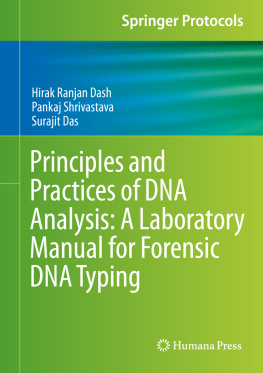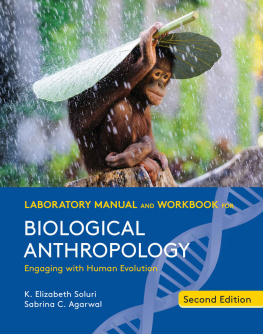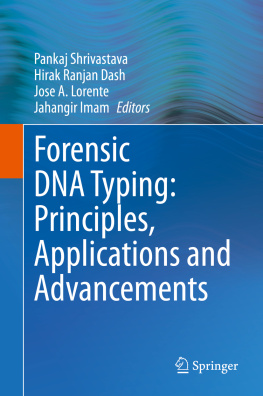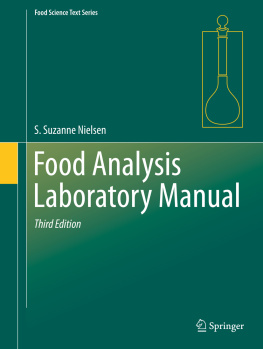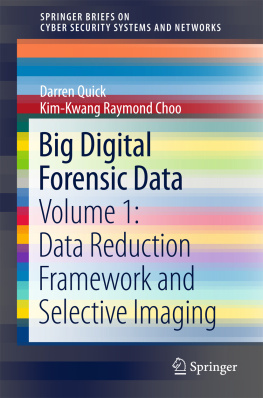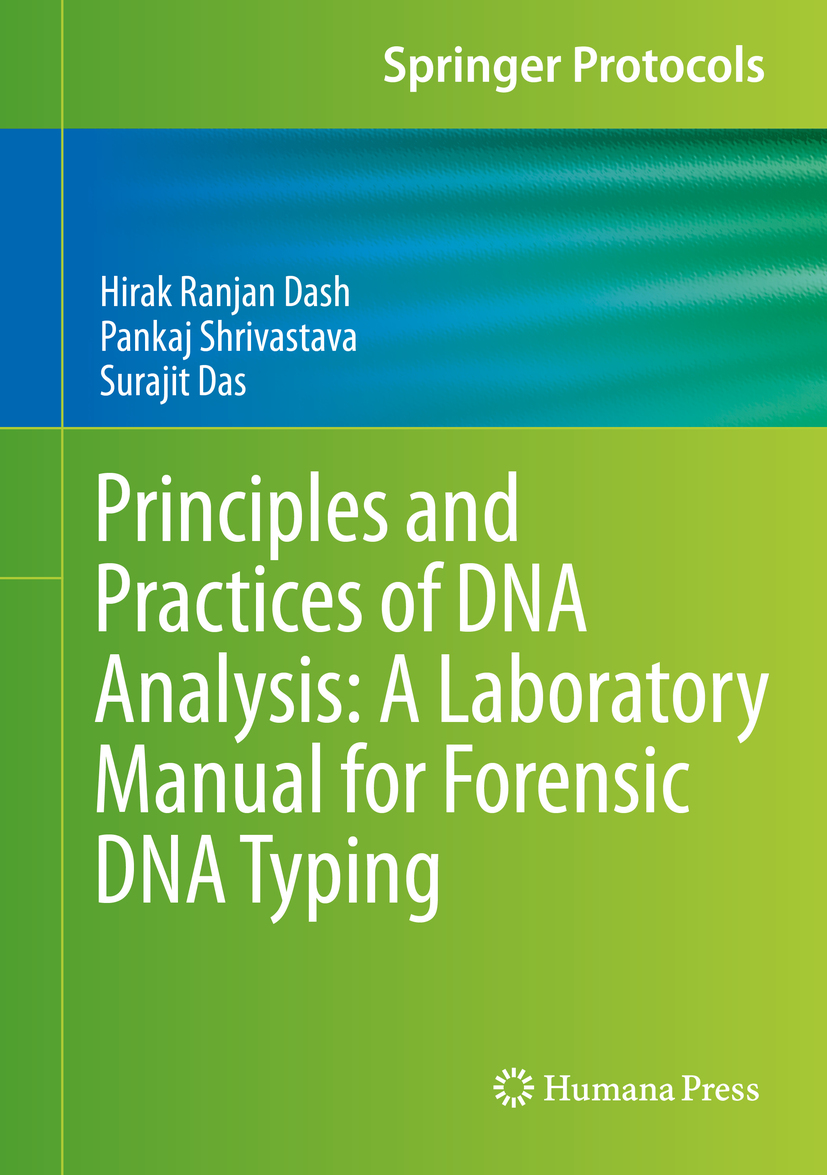Springer Protocols Handbooks
For further volumes: http://www.springer.com/series/8623
Hirak Ranjan Dash , Pankaj Shrivastava and Surajit Das
Principles and Practices of DNA Analysis: A Laboratory Manual for Forensic DNA Typing
Hirak Ranjan Dash
DNA Fingerprinting Unit, State Forensic Science Laboratory, Sagar, Madhya Pradesh, India
Pankaj Shrivastava
DNA Fingerprinting Unit, State Forensic Science Laboratory, Sagar, Madhya Pradesh, India
Surajit Das
Department of Life Science, National Institute of Technology, Rourkela, Odisha, India
ISSN 1949-2448 e-ISSN 1949-2456
Springer Protocols Handbooks
ISBN 978-1-0716-0273-7 e-ISBN 978-1-0716-0274-4
https://doi.org/10.1007/978-1-0716-0274-4
Springer Science+Business Media, LLC, part of Springer Nature 2020
This work is subject to copyright. All rights are reserved by the Publisher, whether the whole or part of the material is concerned, specifically the rights of translation, reprinting, reuse of illustrations, recitation, broadcasting, reproduction on microfilms or in any other physical way, and transmission or information storage and retrieval, electronic adaptation, computer software, or by similar or dissimilar methodology now known or hereafter developed.
The use of general descriptive names, registered names, trademarks, service marks, etc. in this publication does not imply, even in the absence of a specific statement, that such names are exempt from the relevant protective laws and regulations and therefore free for general use.
The publisher, the authors, and the editors are safe to assume that the advice and information in this book are believed to be true and accurate at the date of publication. Neither the publisher nor the authors or the editors give a warranty, expressed or implied, with respect to the material contained herein or for any errors or omissions that may have been made. The publisher remains neutral with regard to jurisdictional claims in published maps and institutional affiliations.
This Humana imprint is published by the registered company Springer Science+Business Media, LLC, part of Springer Nature.
The registered company address is: 1 New York Plaza, New York, NY 10004, U.S.A.
Preface
DNA fingerprinting is one of the greatest discoveries of science in the century. Since its discovery, the technique is being widely used in varied fields such as deciphering the genetics of an organism, cracking ancestral belongingness, neonatal diagnosis, diagnosis of genetic disorder, and many others. However, it has revolutionized the field of criminal justice system by its uniqueness and individualization capabilities. Currently, DNA fingerprinting is considered to be the most irrefutable evidence to be produced before the court of law.
Since its inception, the technique has undergone tremendous advancements, and the progress is being observed continuously. However, with the advent of time a consensus step-by-step protocol book describing the technology currently used is lacking. Most of the books available in the same field either describe the obsolete technique of RFLP for DNA examination or manual DNA extraction procedures. Currently, the technological advancement has seen DNA extraction through automation, and RAPID DNA technology has also arrived. Hence, we felt the need of a timely updated laboratory manual in the current field.
In this context, the laboratory manual is structured to clear all doubts of the examiners as well as students regarding conventional and advanced forensic DNA typing experiments. It will be handy for the beginners as well as for the experts in the field of DNA fingerprinting for smooth conduction of the experiments, interpretation, and analysis of results. The uniqueness of the manual involves (a) step-by-step protocol for each experiments; (b) description of each chemicals and reagents and their corresponding principal/functional role; (c) separate experiments for DNA extraction from varied types of biological samples of forensic interest; (d) description of advanced automatic and semiautomatic techniques for DNA extraction; (e) inclusion of real case studies and statistical analysis; and (f) precaution and troubleshooting for each experiment.
Every possible effort has been made to present the protocol book in a very simpler form for easy understanding of students, scientists, and DNA examiners. We have tried our best to incorporate all our experience and expertise to bring out the form of this manual. Throughout the writing process, we have faced lots of hurdles and problems; however, all of them have been overcome due to Gods grace, self-belief, and support from family and friends. We are really thankful to each and every one for their support and encouragement during the process of writing. We hope the manual will be of great use for the readers in their career.
Wishing the readers all the best for a successful experiment!!!!
Hirak Ranjan Dash
Pankaj Shrivastava
Surajit Das
Sagar, Madhya Pradesh, India Sagar, Madhya Pradesh, India Rourkela, Odisha, India
Contents
Preface v
Part I Overview of Forensic DNA Analysis
Part II Manual Extraction of DNA from Biological Samples
Part III Automatic and Semi-automatic Extraction of DNA from Biological Samples
Part IV Qualitative and Quantitative Assessment of Extracted DNA
Part V Amplification of Various STR Markers Using Multiplex PCR
Part VI Genotyping and Analysis of Results
Part VII Case Studies
Part VIII Advanced Technologies for Forensic DNA Analysis
About the Authors
Hirak Ranjan Dash
is currently a Scientific Officer at the DNA Fingerprinting Unit, Forensic Science Laboratory, in Sagar, Madhya Pradesh, India. He completed his Ph.D. at the National Institute of Technology, Rourkela, India, in 2015, and has since been working in the area of microbial ecology, forensic microbiology, and human genetics. In addition, he is a member of various scientific societies, including the International Society for Forensic Genetics, Association of Microbiologists of India and Students Association of Microbiology. He has been engaged in forensic DNA fingerprinting examinations in criminal and civil cases including the cases related to paternity, child swapping, rape, identity and incest. He has authored more than twenty-five papers in reputed peer-reviewed international journals and has published four books.
Pankaj Shrivastava
has broad interests in several areas of forensic DNA fingerprinting including population-based DNA analysis, developing protocols in forensic DNA typing, validating new multiplex kits and optimizing different steps in forensic DNA typing methodology. He has supervised Ph.D. students and published over 40 research papers in peer-reviewed international journals. His publications in Forensic Science International Genetics, Nature Scientific Reports, Legal Medicine, International Journal of Legal Medicine, Annals in human Biology, etc., have earned him wide acclaim from the forensic DNA community. He is presently working at the DNA Fingerprinting Unit in State Forensic Science Laboratory, Govt. of Madhya Pradesh, India. He is a member of International Society for Forensic Genetics (ISFG), Indian Society of Human Genetics (ISHG), Association of Microbiologists of India(AMI) and Association for the promotion of DNA Fingerprinting and other DNATechnologies (ADNAT).

